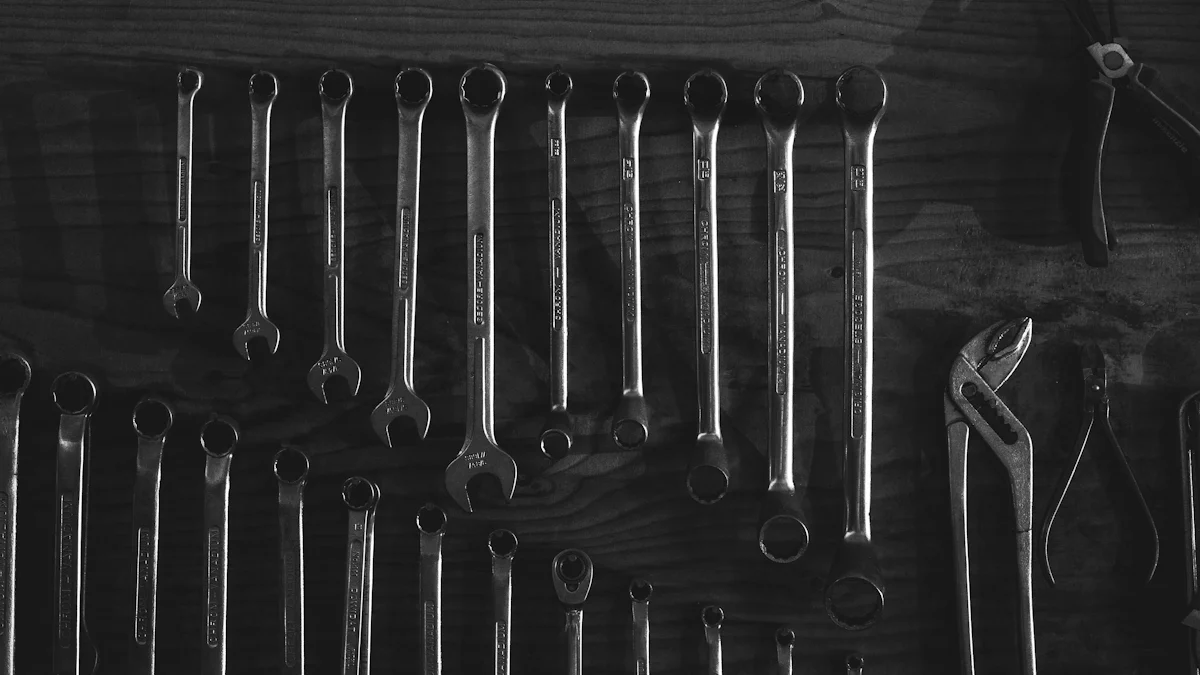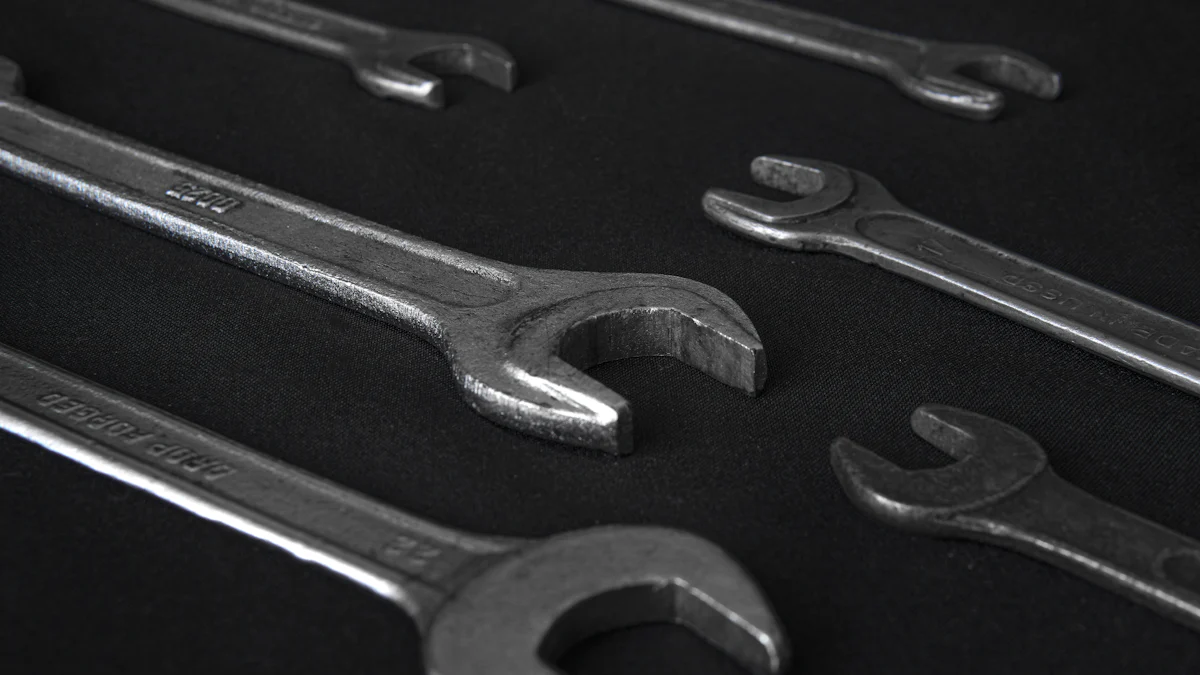
A wheel spanner, also known as a lug wrench, is an essential tool for any vehicle owner. This tool helps in loosening and tightening lug nuts on automobile wheels. Choosing the right wheel spanner ensures ease of use and efficiency during tire changes or maintenance. Different types of wheel spanners offer various features and benefits, making it crucial to select one that suits specific needs. Proper selection can prevent muscle strain and improve overall vehicle maintenance experiences.
Types of Wheel Spanners

L-Type Wheel Spanners
Characteristics
L-Type wheel spanners have an L-shaped design. The long handle provides greater rotational torque. These spanners often come with metric fittings. Some models include a lever end for additional leverage.
Uses
L-Type wheel spanners are ideal for loosening and tightening lug nuts on automobile wheels. The long handle makes it easier to apply force, reducing the effort needed. These spanners are suitable for both professional mechanics and vehicle owners.
Pros and Cons
Pros:
- Provides high torque due to the long handle.
- Easy to use for both professionals and amateurs.
- Available in various metric sizes.
Cons:
- Can be bulky to store.
- May not fit all lug nut sizes.
T-Type Wheel Spanners
Characteristics
T-Type wheel spanners feature a T-shaped design. The crossbar allows for two-handed operation. These spanners often come with interchangeable sockets. The design provides balanced force distribution.
Uses
T-Type wheel spanners are useful for tasks requiring balanced force. The T-shape allows for easy handling and better control. These spanners are commonly used in automotive repair shops.
Pros and Cons
Pros:
- Balanced force distribution.
- Two-handed operation for better control.
- Interchangeable sockets for versatility.
Cons:
- Can be cumbersome to handle in tight spaces.
- Requires more storage space.
Cross-Type Wheel Spanners
Characteristics
Cross-Type wheel spanners have a cross-shaped design. This design offers four different socket sizes. The spanner is usually made from durable steel. The cross shape provides excellent leverage.
Uses
Cross-Type wheel spanners are versatile tools. They can handle multiple lug nut sizes. These spanners are often found in emergency car kits. The design allows for quick tire changes.
Pros and Cons
Pros:
- Four socket sizes in one tool.
- Excellent leverage for loosening tight nuts.
- Durable construction.
Cons:
- Bulky and heavy.
- Not as portable as other types.
Telescopic Wheel Spanners
Characteristics
Telescopic wheel spanners feature an extendable handle. This design allows for adjustable length, providing greater leverage when needed. The spanner often includes a dual socket head, accommodating different lug nut sizes. Constructed from durable materials like chrome vanadium steel, these spanners ensure longevity and resistance to wear.
Uses
Telescopic wheel spanners excel in situations requiring high torque. The extendable handle makes it easier to loosen stubborn lug nuts. These spanners are ideal for both professional mechanics and vehicle owners. The compact design allows for easy storage in car trunks or toolboxes. Telescopic spanners also prove useful for roadside emergencies.
Pros and Cons
Pros:
- Adjustable length for increased leverage.
- Dual socket head for versatility.
- Durable construction from high-quality materials.
- Compact and easy to store.
Cons:
- May require more effort to adjust the handle.
- Can be more expensive than standard spanners.
Factors to Consider When Choosing a Wheel Spanner
Material and Durability
Types of Materials
The material of a wheel spanner significantly impacts its performance and lifespan. Common materials include chrome vanadium steel, which offers excellent strength and resistance to wear. Some spanners use carbon steel, known for its durability and cost-effectiveness. Stainless steel provides corrosion resistance, making it suitable for humid environments.
Durability Factors
Durability depends on the material quality and construction method. Heat-treated spanners offer enhanced strength and longevity. A protective coating, such as chrome plating, prevents rust and corrosion. High-quality welds and joints ensure the tool withstands heavy use without breaking.
Size and Fit
Importance of Correct Size
Choosing the correct size ensures the wheel spanner fits the lug nuts perfectly. An improper fit can strip the lug nuts, making removal difficult. The right size also provides better torque application, reducing the effort needed to loosen or tighten nuts.
How to Measure
To measure the correct size, check the lug nut dimensions on your vehicle. Use a caliper or a measuring tape to determine the diameter. Refer to the vehicle’s manual for specific size recommendations. Ensure the spanner matches these measurements for optimal performance.
Ease of Use
Ergonomic Design
An ergonomic design enhances user comfort and efficiency. Look for spanners with non-slip grips that reduce hand fatigue. A well-balanced tool distributes force evenly, making tasks easier. Features like extendable handles provide additional leverage without extra effort.
Weight and Portability
Weight affects the ease of handling and portability. Lighter spanners are easier to maneuver but may lack the strength of heavier models. Compact designs, such as telescopic spanners, offer easy storage in car trunks or toolboxes. Consider the balance between weight and durability for the best user experience.
Maintenance and Care for Wheel Spanners

Cleaning Tips
Regular Cleaning
Regular cleaning of a wheel spanner ensures optimal performance and longevity. Use a soft cloth to wipe off dirt and debris after each use. Mild soap and water can remove stubborn grime. Dry the spanner thoroughly to prevent rust formation. Regular cleaning maintains the tool’s efficiency and appearance.
Deep Cleaning
Deep cleaning becomes necessary when a wheel spanner accumulates significant dirt or grease. Use a degreaser to break down tough residues. Scrub the spanner with a brush to reach crevices and joints. Rinse thoroughly with water and dry completely. Apply a light coat of oil to metal parts to prevent rust. Deep cleaning restores the spanner to its original condition.
Storage Tips
Proper Storage Methods
Proper storage methods protect a wheel spanner from damage and wear. Store the spanner in a dry, cool place to avoid moisture exposure. Use a toolbox or dedicated storage case to keep the tool organized. Avoid placing heavy objects on top of the spanner to prevent bending or deformation. Proper storage extends the lifespan of the tool.
Avoiding Rust and Corrosion
Avoiding rust and corrosion is crucial for maintaining a wheel spanner. Apply a protective coating, such as WD-40, to metal surfaces. Store the spanner in a moisture-free environment. Use silica gel packs in the storage area to absorb excess humidity. Regularly inspect the spanner for signs of rust and address any issues promptly. Preventing rust ensures the spanner remains functional and reliable.
A wheel spanner proves essential for vehicle maintenance. Different types offer unique benefits and drawbacks. L-Type, T-Type, Cross-Type, and Telescopic wheel spanners each serve specific purposes. Material, size, and ease of use play crucial roles in selection. Proper maintenance ensures longevity and reliability. Choosing the right wheel spanner enhances efficiency and safety. Consider individual needs and preferences when selecting a wheel spanner. The correct choice simplifies tire changes and reduces effort.
See Also
Discovering the Range of Socks for Males and Females
Top Tips for Warm Winter with Soft Cozy Socks
